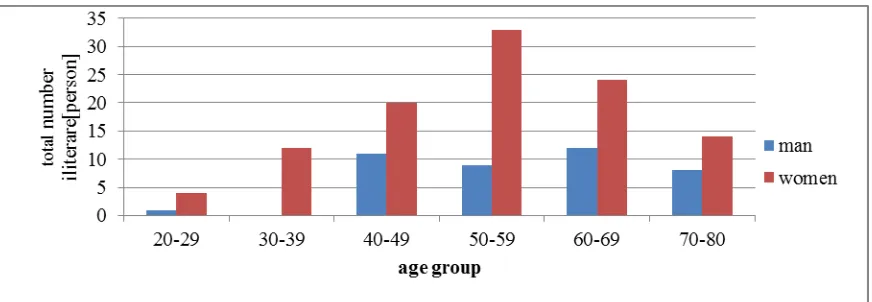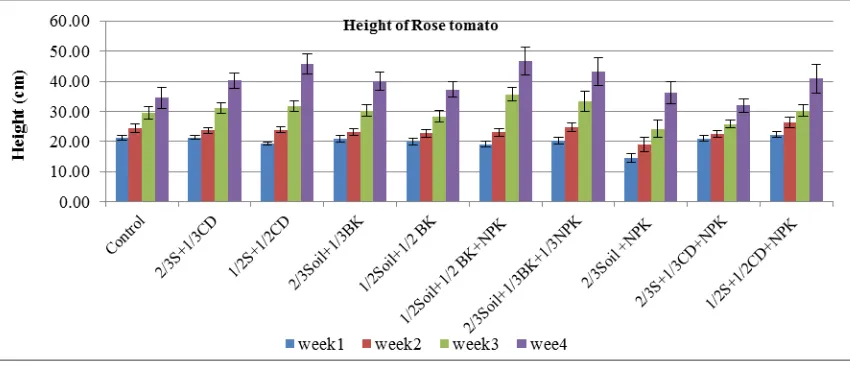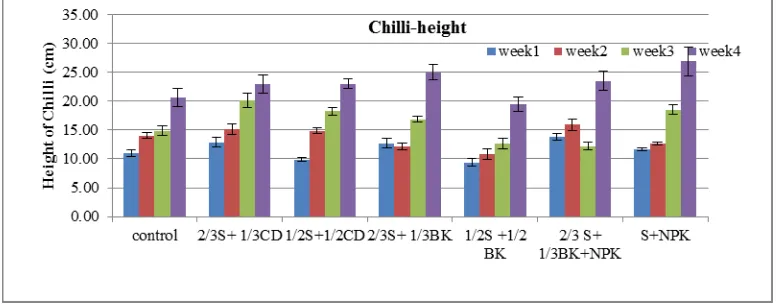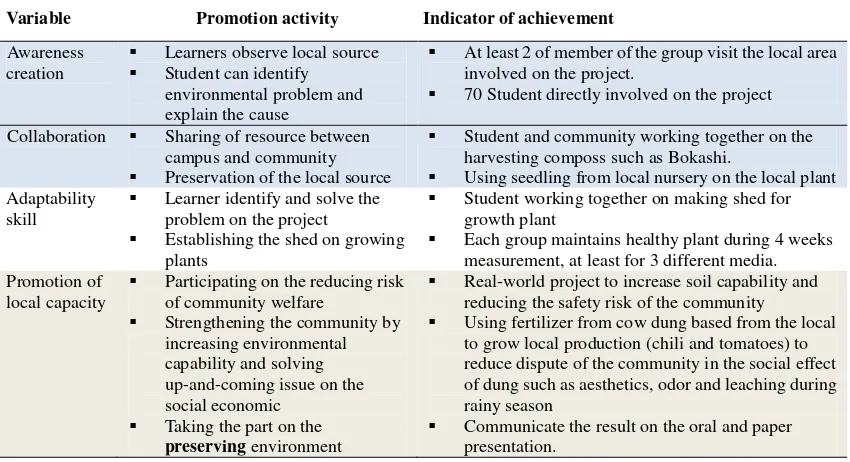The 4thInternational Symposium for Sustainable Humanosphere (ISSH)
A Forum of Humanosphere Science School (HSS) Bandung, 22 -23December 2014
ASSESSING DeepSAe MODEL ON GROWING CHILI AND ROSE TOMATOES TO PROMOTE HARMONIOUS HUMANOSPHERE ON THE LOCALS AND SUSTAINABILITY
Arry Y Nurhayati1
* and Yuda C Hariadi
11
Physics Department Faculty of Mathematics and Natural Sciences, University of Jember (Unej), Jember 68121, East Java, Indonesia
*Corresponding author: arrynurhayati@gmail.com
Abstract
A phenomenon of declining environmental capacity to support sustainable agricultural production has been noted. The possible cause for this is improper balance of chemical fertilizer usage on farming practices for long durations. The dependency on chemical fertilizers—which tends to be expensive and scarce— burdens the local farmer communities with many among them were in vulnerable positions without proper education, income under 1$ per day, illiterate, and with limited access to information. This research was designed to support the locals on utilizing their waste material such cow dung and agricultural biomass to support their production on chili and rose tomatoes. Seventy students of physics have been participated in the project under DeepSAe-deep learning student-environment model by growing chili and rose tomatoes under different compositions of soil and fertilizer. Approximately 3 weeks old healthy and homogenous seedlings of chili and rose tomatoes from a local nursery were transported to university and grown in plastic pot containers under 10 different treatments and five replicated to meet statistical purposes. The growth was then observed weekly for four weeks. The results showed that the addition of one-thirds of organic fertilizer gave better growth on rose tomatoes and chili. We conclude that the DeepSAe model was effective on promoting harmonious humanosphere on local community and sustainability.
Keywords: DeepSAe-model; harmonic humanosphere; sustainability; chili; rose tomatoes.
Introduction
A phenomenon of declining environmental capacity to support sustainable agricultural production has been noted. The possible cause for this is improper balance of chemical fertilizer usage on farming practices for long durationsleading to decreasing food productivity [1, 2, 3].The dependence on using chemical fertilizer to support high yield production often becomes a burden to the local farmer community when those fertilizers become too expensive and scarce on the market. Among the local farmers, some were in vulnerable positions, illiterate, had limited access to information and living under 1$ a day (Figure 1). The lack of knowledge on proper dosage causes improper balanced use of fertilizers.
Some positive impacts of organic fertilizer on plants— including manure— on plants has been reported, such as increased height and leaf numbers on Okra [1]; production of sweet corn [4]; fruit and yield of tomato[5]. Even though manure has positive impacts on plant growth, it has yet to become a complete solution of nutrition in large scales [6], however repeating the application of compost may increase N content, saved in mineralization for the next growing season [7]. This will be a great benefit to the farmers by saving money and better returns on farming practice.
The 4th International Symposium for Sustainable Humanosphere (ISSH)
A Forum of Humanosphere Science School (HSS) Bandung, 22 -23December 2014
The project was designed to participate in fixing community problems to reduce threats to harmonious existence between environment and vulnerable community. The research was aimed to promote the use organic fertilizers to maintain the sustainability of farmer productions in such a way preserves the harmony between nature and the locals.
Promoting sustainability to students and local community is urgently needed to increase the awareness of potential risks to environment and threats to human health. The successful implementation of the community based project is a strategy to promote sustainability in the communities. Assesments including the biophysical measurement could be done by integrating the learning process. That strategy needs cooperation and collaboration among students and local community. Learning process should be aligned to support the multiple dimensions on sustainability. In doing these we need a framework from physics students to be aligned on the social dimension, such as DeepSAe model [12,13] that has shown to be positive on the radiology course.
The DeepSAe model has the students to actively explore and promote sustainability to the locals and promote the existence of harmony between the people and the environment, whilst still keeping the learning efficiency needed to sustain the model. The sustainability promotion is programmed is a real world assessment, and highly situated for the social dimensions [14] as well as measurement on the biophysical pillars in assessing the sustainability. 70 students of biophysics participated and taught to interact with their environment to have deep understanding on the biological systems. Under the deepSAe model students were expected to gain the ability to think critically, able to analyze, and solve complex problems to understand the biological process. The participating strategy of this model will create a program that aims to strengthen environmental and economic security of local communities by supporting and promoting ground-breaking solutions that challenge to lessen and adapt to climate change effects.
Investigation on the parameter of biophysics should support survivability of locals on the economic, social and the capability of the environment to support the locals in the long term.
Bringing them to the class learning process needs a concept of education for harmonious future, i.e involving in the preservation of the land for future generations and respect for nature [15]. Nature and environment may be viewed differently or interchangeably. According to Bourdeou [16] definitions on environment ranged from Einstein’s definition i.e. “everything that is not us” to the
European Union: “the whole set of elements which forms the frameworks, the surroundings and the living conditions of a man and society, as they are or as they are perceived”.
To promote sustainability we need sustainability assessment in analyzing the local resources and evaluate the monitoring data thus giving feedback to make strategic management and adapt to the environment and work in harmony. Therefore we added another pillar to make dynamic harmonious interaction to support sustainability i.e biophysical indicator. The examples of Biophysical indicator used were leave area, photosynthetic capacity, biomass production [17].
Promoting harmonious humanosphere and sustainability on the locals mean increasing awareness, taking action, processing, practicing, strategy on managing science, keeping on track to support sustainable environmental by reducing threat on the environment and the locals, and maintain balance on the economic values and long term effect. In order to that we need a framework that may balance the need of the education of the harmonious humanosphere and sustainability on the local community. Here we use DeepSAe model, deep learning student active environment that we have built since 2011.
Materials and Methods / Experimental
The 4th International Symposium for Sustainable Humanosphere (ISSH)
A Forum of Humanosphere Science School (HSS) Bandung, 22 -23December 2014 Figure1. Condition of the local community.
Materials and Methods / Experimental
DeepSAe Model-Deep learning Student Active environment
The framework of the deepSAe model were shown on Figure 2.
Figure 2 Framework of DeepSAe Model
Data collection and analysis/ experiment procedures
The main objective of the experiments was to evaluate the effect of different doses of bio- compost and cow dung compost alone, and their combination with the inorganic fertilizer on growth, and biophysical character on the sustainability. Homogenous and healthy grown 21 days old seedlings from Chili and tomatoes from the local nursery was selected, and transported to the Biophysics Lab. The plants were then further grown on the 10 different compositions of soil mixture and fertilizer and each replicated 5 times for statistical purpose. The growth was observed weekly for four weeks.
Environmental capability; long term effect
Campus (student and lecturers, science,system)
Community, Up-and-coming-issue
Increasing awarenes of long term effects to sustain environmental capability Building adaptability in the suddent change on the climate
Participating on the reducing risk of community welfare
Assissting on the strenghten the community by investigation and balancing between environmental capability and up-and-coming-issue on the social economic
The 4th International Symposium for Sustainable Humanosphere (ISSH)
A Forum of Humanosphere Science School (HSS) Bandung, 22 -23December 2014 Results and Discussion
Biophysical Measurement on growth Chili and Rose Tomatoes
Investigation on the first four weeks showed growth that the application of cow dung, Bokashi and NPK has affected on the growth of chili and rose tomatoes. Different ratio of media composition had affected the height of the chili and rose tomatoes, leaf area and numbers. No sign of chlorosis symptoms were noticeable on the leaves on most of the treatment simply because the treatment did not caused stress on the plant.
(a) (b) (c)
Figure 3 (a) Rose Tomato grown in the garden of a local community, pictured on September 3rd 2014. On the time of planting fertilizer were scarce in the market limited number of fruit; (b) rose tomatoes grown in different composition of fertilizer; (c) healthy leaf and larger leaf area, and earlier flower in the addition of 1/3 Bokashi based cow dung.
Figure 4 Height of Rose tomatoes growth under different treatment of fertilizer based cow dung.
The 4th International Symposium for Sustainable Humanosphere (ISSH)
A Forum of Humanosphere Science School (HSS) Bandung, 22 -23December 2014 Figure 5 Leaf areas of rose tomato grown under different fertilizer
Figure 6 Chili growth under different treatment of fertilizer based cow dung; left control plant, 2/3 soil +1/3 cow Dung ; 2/3 soil +1/3 Bokashi; 1/2 soil +1/2 cow dung ; 1/2 soil +1/2 Bokashi
The 4th International Symposium for Sustainable Humanosphere (ISSH)
A Forum of Humanosphere Science School (HSS) Bandung, 22 -23December 2014 Figure 8. Leaf area of Chili grown under different composition of manure on the growing media during observation week-1 to week-4
Promoting the Harmonious Humanosphere and Sustainability on the Local Community
Under DeepSAe model the collective contribution and strategy had been shown in the demonstrating the solution on the priorities cases on the local. Most of the students of the members of group had experience on doing measurement, participating on the seminar to communicate the results and give and accept the feedback from the peers (Table 1). The increasing awareness on the long term effect concerning the mismanaged environment had been done by promoting the positive impact of the converting livestock and agricultural waste into valuable product at least on the application during the stage growth on the both plant chili and tomatoes. The local chili can be harvested in around three times during their life cycle. The rose tomatoes were heirloom tomatoes; both chili and tomatoes have been used for many decades by the farming and still have a good production in proper treatment.
.
a b c d
Figure 9. Assessing the DeepSAe model; (a,b) student and community learning together to turn cow dung into Bokashi; (c) selecting seedling from local nursery; (d) growing in the similar shed on the local Biophysical lab.
Rough analysis on the program have a potential to increase addition income at least $2/day on the periodic production. The chili often becomes a hot product due to instability of the price, we have noted the increase of chili price on the market has increased doubled from $5/kg to $10(based in the conversion $1=IDR.12500). If the need of chili and tomatoes can be supported by the locals, not only that we have the possibility to increase income of the vulnerable people, or solution on the solid waste management but also a message that every photosynthetic product will produce oxygen event in a small but steady and simultaneously resulting in a harmony that will support the globe. Further research need to have better doses and rate [18,19] to use fertilizer efficiently.
The 4th International Symposium for Sustainable Humanosphere (ISSH)
A Forum of Humanosphere Science School (HSS) Bandung, 22 -23December 2014 Table 1 Achievement indicator of the assessing DeepSAe model on promoting the harmonious humanosphere on the local and the sustainability
Variable Promotion activity Indicator of achievement
Awareness creation
Learners observe local source Student can identify
environmental problem and explain the cause
At least 2 of member of the group visit the local area involved on the project.
70 Student directly involved on the project
Collaboration Sharing of resource between campus and community Preservation of the local source
Student and community working together on the harvesting composs such as Bokashi.
Using seedling from local nursery on the local plant Adaptability
Student working together on making shed for growth plant
Each group maintains healthy plant during 4 weeks measurement, at least for 3 different media. Promotion of
Real-world project to increase soil capability and reducing the safety risk of the community
Using fertilizer from cow dung based from the local to grow local production (chili and tomatoes) to reduce dispute of the community in the social effect of dung such as aesthetics, odor and leaching during rainy season
Communicate the result on the oral and paper presentation.
Conclusion
The result has shown that addition of one-thirds of organic fertilizer had given a better growth on rose tomatoes and chili. Adjustments in the application of organic fertilizer to chemical fertilizer composition has a potential to increase the growth of Chili and Rose Tomatoes, therefore might be a good alternative to chemical fertilizer treatment. Converting agricultural solid waste to organic fertilizer has an economically valuable benefit in strengthening the local community’s social economy by supporting farming activity and leading to sustainability.
Promoting the use of agricultural solid waste by encouraging the greater use of cow dung as a raw source of nutrients available for plants, reduce several obstacles that can be a major issues on the local community practice such as public perception regarding odor issues, potential pollutants concerning livestock (farm animal) waste organic material; nutrient and pathogenic microorganism, surface water is primarily affected through soluble contaminants in a run off or insoluble pollutants carried by soil particles during an erosion event.
This result was based on the measurement of 4 weeks of experiment; further measurement is needed to a complete result. We conclude that the DeepSAe model was effective on promoting harmonious humanosphere on the local community and promote sustainability.
Acknowledgment
The authors would like to thanks the local farmer Mr. Saiful who has provided the cow manure, and participated on the making of Bokhashi. Also the students who had participated on the projects. Special thanks to A.Solihin who has been a great help on the constructing the DeepSAe website.
References
[1] Tiamiyu, R.A., H.G. Ahmed, & A.S. Muhammad. 2012. Effect of Source of Organic Manure on Growth and Yields of Okra (Abelmoschus esculentus L.) in Sokoto, Nigeria. Nigerian Journal of Basic and Applied Science. 20 (3): 2013-2016.
The 4th International Symposium for Sustainable Humanosphere (ISSH)
A Forum of Humanosphere Science School (HSS) Bandung, 22 -23December 2014 [3] Bhuiyan, N.I., P.K.Saha, M.Ishaque & J.Abedin. Studies on Inorganic Nutrients and Organic
Residues for Rice-based Cropping Systems in Bangladesh.83-90.
[4] Asroh, 2010. Pengaruh Takaran Pupuk Kandang dan Interval Pemberian Pupuk Hayati terhadap Pertumbuhan dan Hasil Tanaman Jagung Manis (Zea mays Saccharata Linn). Agrobis. 2(4): 1-6.
[5] Eivazi, A.R., A.R. Rastegarni, Y. Habibzadeh, A.F. Mogaddam, & G. Khililzadeh. 2013. Influence of Manure Fertilizers on Morpho-physiological Traits of Tomato (Lycopersicun escutentum Mill).Peak Journal of Agricultural Sciences. 1(6):89-93.
[6] Bationo, A., S.M. Nandwa, J.M. Kimetu, J.M. Kinyangi, B.V. Bado, F. Lampo, S. Kimani, F. Kihanda, and S. Koala. 2004. Sustainable Intensification of Crop-livestock Systems through Manure Management in Eastern and Western Africa: Lesson, Learned and Emerging Research Opportunities. Sustainable crop-livestock production in West Africa. 173-196.
[7] Diacono, M., Montemurro, F., 2010.Long-term Effects of Organic Amendments on Soil Fertility. A review. Agron Sustain Dev. 30 : 401-422.
[8] Zhang, F., Y. Li, M.Yang, & W. Li. 2012. Content of Heavy Metals in Animal Feeds and Manures Farms of Different Scales in North East China. Int. J.Environ.Res.Public Health. 9 : 2658-2668.
[9] Sherene. 2010. Mobility and Transport of Heavy Metals in Polluted Soil Environment. An International Journal . 2(2):112-121
[10] Ntui, N.T, U.F. Hassan, & O.A. Ushie. 2014. Determination of Heavy Metals Concentration in Cow dung of Grazing Cattle in Bauchi Urban Area, Nigeria. International Journal of
Modern Analytical and Separation Sciences. 3 (1):13-19.
[11] Nicholson, F.A., B.J. Chambers, J.R.William, & R.J. Unwin. 1999. Heavy Metal Contents of Livestock Feeds and Animal Manures in England and Wales. Bioresource Technology .70: 23-31.
[12] Nurhayati, A.Y., & Y.C. Hariadi. 2011. Effective Student Centered Learning in Radiology
Course: “Developing DeepSAe Model to Challenge the Sat Century Skill”. PHKI Universitas
Jember 2011. www.deepSae.web.id.
[13] Boud,D., N. Falchikov,N. 2006. Aligning assessment with long-term learning. Assessment &Evaluation in Higher Education 31(4):339-413.
[14] Rahman, M.A., Rahman, M,M,m Begum, M.F., Alam, M.F., 2012. Effect of bio compost, cow dung compost and NPK fertulizers on growth, yield and yield components of chili. Int. J.Biosci. 2(1):51-55. IJB 2(1)-p51-55. (49-55) assesed on September 2014.
[15] Avery, J. 2005. Learning to Live in Harmony. p.1-23. www.learndev.org/dl/harmony8.pdf. Assessed on 13 December 2014.
[16] Bourdeau, Ph. 2004. The man-nature Relationship and Environmental Ethics. Journal of Environmental Radioactivity. 72:9-15.
[17] Kimmins, J.P., R.S.Rempel, C.V.J.Welham, B.Seely,&. K.C.J. Van Rees. 2007. Biophysical sustainability, proses –based monitoring and forest ecosystem management decision support systems. The Forestry Cronicle. 83 (4):502-514.
[18] Gudugi, I.A.S., M.K. Isah, & A.N. Giragi, 2012. Effect of Different Rates of Poultry Manure on the Growth and Yield of Sweet Corn (Zea mays sacharata). Indian J.Sci.Res 3(2):13-16




